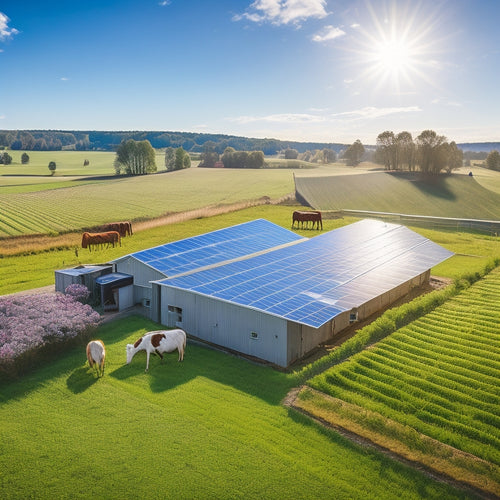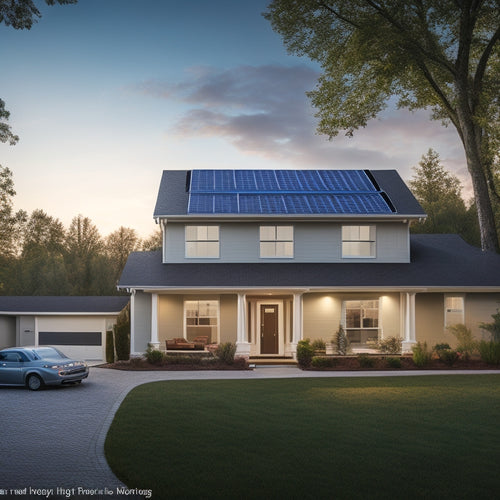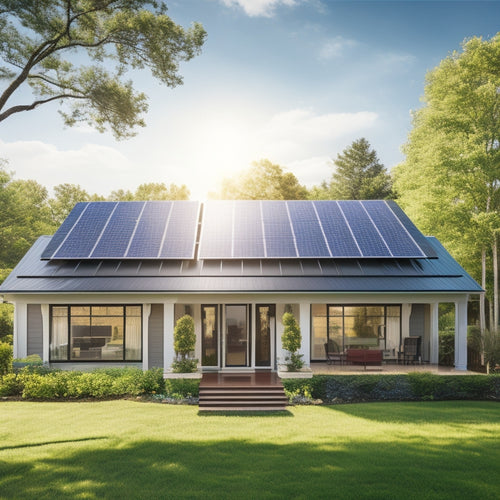
Winter-Proof Your Home: Essential Efficiency Upgrades
Share
To winter-proof your home, start by insulating and sealing air leaks around windows, doors, and outlets to retain heat. Upgrade to energy-efficient windows with low U-factors, and optimize your heating system by cleaning filters, sealing duct leaks, and installing a smart thermostat. Verify your attic insulation meets the recommended R-38 value, and consider adding radiant barrier insulation on your roof deck. Finally, consider investing in smart home energy management systems to monitor and track your energy consumption. By implementing these essential upgrades, you'll be well on your way to reducing energy bills and carbon footprint - and uncovering even more ways to enhance your home's efficiency.
Key Takeaways
- Insulate and seal air leaks around windows, doors, and outlets to retain heat and reduce energy bills.
- Upgrade to energy-efficient windows with low U-factors to minimize heat transfer and save up to $465 annually.
- Optimize your heating system by cleaning air filters, sealing duct leaks, and installing a smart thermostat to minimize energy waste.
- Improve attic insulation to at least R-38 with materials like fiberglass batts or spray foam to prevent significant heat loss.
- Install smart home energy management systems to monitor consumption, identify inefficiencies, and make data-driven decisions.
Insulate and Seal Air Leaks
As winter's chill sets in, heat can escape through even the tiniest openings, driving up your energy bills and making your home less comfortable. To prevent this, you'll need to identify and seal air leaks using drafting techniques.
Start by inspecting your home's exterior, paying close attention to gaps around windows, doors, and electrical outlets. By doing so, you'll be taking a step towards energy independence and reducing your reliance on utility companies. Seal these openings with caulk or weatherstripping to prevent heat from escaping.
Additionally, consider investing in renewable energy solutions like off-grid solar systems, which can greatly reduce your carbon footprint.
Next, inspect your attic, walls, and floors for adequate insulation. Add thermal barriers, such as fiberglass batts or spray foam, to reduce heat transfer.
Upgrade to Energy-Efficient Windows
Most homes have at least one inefficient window, and replacing them can be a significant step towards energy savings. When selecting new windows, consider the window materials and energy ratings to guarantee you're getting the most efficient option. Here's a breakdown of popular window materials and their energy efficiency:
| Window Material | Energy Efficiency |
|---|---|
| Vinyl (PVC) | High, with U-factors as low as 0.27 |
| Aluminum | Medium, with U-factors around 0.73 |
| Wood | Medium, with U-factors around 0.55 |
| Fiberglass | High, with U-factors as low as 0.32 |
| Composite | High, with U-factors as low as 0.29 |
Look for windows with low U-factors, which measure heat transfer, and high R-values, which measure insulation. Replacing your old windows with energy-efficient ones can help you save up to $465 per year on energy bills.
Optimize Your Heating System
Frequently, homeowners overlook the importance of maintaining their heating systems, leading to reduced efficiency and increased energy bills. To avoid this, prioritize heating system maintenance before winter.
Check your system's air filters, clean or replace them as needed, and guarantee proper airflow. Inspect ducts for leaks and seal them to prevent heat loss.
Additionally, consider conducting an energy needs assessment to identify areas of improvement and optimize your system's performance. By doing so, you can create a detailed breakdown of energy usage and develop strategies to reduce energy waste.
Next, adjust your thermostat settings to optimize performance. Consider installing a smart thermostat, which can learn your schedule and preferences to minimize energy waste. Set the temperature to 68°F (20°C) when you're awake and active, and lower it by 5-10°F (3-6°C) when you're asleep or away.
Improve Insulation in Attics
Now that you've optimized your heating system, it's time to focus on another key area: your attic's insulation. Adequate attic insulation is vital to preventing heat loss and maintaining a warm living space. It's important to guarantee your attic has a sufficient thermal barrier to keep the cold air out.
| Material | R-Value (per inch) |
|---|---|
| Fiberglass batts | 3.1-4.3 |
| Cellulose insulation | 3.5-3.8 |
| Spray foam insulation | 5.5-6.5 |
| Reflective insulation | 2.7-3.5 |
Check your attic's insulation levels and consider upgrading if they're below the recommended R-38 for most attics. You can add insulation to your attic floor or consider installing radiant barrier insulation on the roof deck. Proper attic insulation will help you save energy and reduce your heating bills.
Smart Home Energy Management
You've optimized your heating system and improved your attic's insulation, but there's still more to do to winter-proof your home. Smart home energy management is the next step in maximizing your energy efficiency.
Invest in a smart thermostat that can learn your schedule and preferences to optimize heating and cooling. This device can also be controlled remotely, ensuring you don't waste energy when you're away.
Additionally, consider an energy monitoring system that provides real-time data on your energy consumption, allowing you to identify areas of inefficiency and make data-driven decisions to reduce your energy usage, much like Advanced Data Analytics Platforms that enable real-time performance tracking and identification of improvement areas.
By leveraging such advanced analytics, you can optimize your energy output and system configuration.
Frequently Asked Questions
Can Energy-Efficient Upgrades Increase My Home's Resale Value?
You'll be happy to know that energy-efficient upgrades can greatly enhance your home's resale value, as they're in high demand according to current market trends, offering substantial resale benefits that'll make your property stand out to potential buyers.
How Do I Prioritize Which Upgrades to Do First?
You're probably thinking, 'Why prioritize when I can just upgrade everything at once?' But, realistically, you have budget considerations. Start by tackling seasonal timing-sensitive upgrades, like insulation and weatherstripping, to maximize immediate energy savings, then move on to others.
Are There Any Government Incentives for Energy-Efficient Upgrades?
You can investigate government incentives like tax credits and rebate programs for energy-efficient upgrades, such as the Federal Solar Investment Tax Credit, which offers up to 26% of eligible costs, and state-specific programs like California's Energy Upgrade California Initiative.
Can I DIY Some Energy-Efficient Upgrades or Hire a Pro?
You're the captain of your energy-efficient ship, charting a course for savings. You can DIY upgrades like installing low-flow fixtures, but for complex tasks, consider hiring a pro for professional consultations to guarantee a smooth, efficient voyage.
Will Energy-Efficient Upgrades Really Lower My Energy Bills?
You'll likely see energy savings from upgrades, but to what extent? Conduct a cost comparison to determine the payback period; if the savings outweigh the investment, you'll reap the benefits of reduced energy bills over time.
Related Posts
-

What Do I Need to Know About Farm Solar Panels
When considering farm solar panels, you need to assess costs, benefits, and technical specifics. Initial investment c...
-

Cost of Solar With Battery Backup
You're investing in a solar panel system with battery backup to guarantee reliable power during outages. The cost of ...
-

Home Solar Installation Cost
You're considering installing solar panels on your home, and the upfront cost is likely the biggest hurdle standing i...


